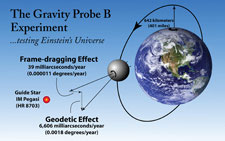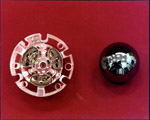WEEKLY HIGHLIGHTS FOR 29 OCTOBER 2004:
GRAVITY PROBE B MISSION UPDATE

In its 28th week in orbit, GP-B is continuing to perform well. We have completed
two months of data collection, and the quality of the data received thus far
is excellent. The spacecraft is maintaining a constant roll rate of 0.7742
rpm (77.5 seconds per revolution) and flying drag-free around gyro #3. The
Dewar temperature remains stable at 1.82 kelvin, and the flow of helium from
the Dewar through the micro thrusters is nominal. All other spacecraft subsystems
are continuing to perform well.

This past Wednesday evening, for the first time since 1918, when Austrian
physicists, Josef Lense and Hans Thirring published their important paper on
the gravitomagnetic or “frame-dragging” effect, the Boston Red
Sox swept the World Series. Some say the heavens responded with a glorious
total eclipse of the moon—or perhaps, it was the eclipsed moon that enabled
the Red Sox to achieve this stunning victory. Whatever the case, these cosmic
events had absolutely no effect on the GP-B spacecraft.
However, in preparation for solar events that could have an effect on our
spacecraft, yesterday, the GP-B Mission Operations team performed an all-day
simulation of the recovery process we will need to go through in the unlikely
event that proton radiation from the sun temporarily disables our main, A-side
computer, triggering an automatic switch-over to our backup, B-side computer.
Chances of such a switch-over increase slightly whenever our spacecraft passes
through the region over the South Atlantic Ocean, called the “South Atlantic
Anomaly,” where the fluxes of particles trapped in the earth’s
geomagnetic field are greater than anywhere else. (See our weekly highlights/update
from 17 September
2004.)

In fact, this may have been the cause of the B-Side switch-over we experienced during the second week of the mission. At that time, we were just beginning to adjust various parameters on the spacecraft, and switching back to the A-side computer went smoothly and quickly. Now that we are well into the science phase of the mission, flight-control parameters have changed, so it is prudent to rehearse the recovery procedures in order to minimize down time and loss of data in the event of a switch-over. To this end, we were pleased with the team’s excellent performance during yesterday’s simulation.
Again, this past week, oscillations in the drag-free control force that we have reported on in previous updates remained insignificant. We are continuing to perform analysis and adjustments on the drag-free suspension parameters to ensure that no harmonic coupling occurs between the drag-free control system and helium sloshing in the Dewar, and we continue to monitor this situation.
Likewise, increasing the signal to noise ratio in the Gyro Suspension System (GSS) position readouts of gyros #3 and #1 appears to have mitigated the problems we experienced with these gyros unexpectedly transitioning to analog suspension mode. Both gyros #3 and #1 have both remained digitally suspended this past week, and we are continuing to monitor the performance of their suspension systems.
On Thursday, 21 October 2004, our GP-B external Science Advisory Committee,
chaired by Professor Clifford M. Will of Washington University in St. Louis,
met here at Stanford and conducted a valuable review of our science data processing
approach.
Drawings & photos: The diagram of the GP-B experiment, the map of the South Atlantic Anomaly region, and the red gyro photo are all from the GP-B Image Archives here at Stanford. The photo of the lunar eclipse is from NASA. Click on the thumbnails to view these images at full size.
Please Note: We will continue updating these highlights and sending out the GP-B email update on a weekly basis—at least through the first few weeks of the Science Phase of the mission. As mission operations become more routine, we may reduce the frequency of these updates to biweekly. However, from time to time, we intend to post special reports and special updates, as warranted by mission events.
SWISS AMATEUR ASTRONOMER PHOTOGRAPHS GP-B GP-B SPACECRAFT IN ORBIT WITH GUIDE STAR IM PEGASI
To the right, is a thumbnail of a photograph of the GP-B spacecraft in orbit, along with the guide star, IM Pegasi. (Click on the thumbnail to view the photo at full size.) The photo was taken and emailed to us by Stefano Sposetti, a Swiss physics teacher and amateur astronomer. Stefano used a 40cm newtonian telescope, with a CCD camera and 20mm wide field lens attached to make this photo. He then sent us the two versions shown — the normal (black sky) version on the right, and an inverse version in which the constellation, Pegasus, the guide star IM Pegasi, and the path of the GP-B spacecraft are highlighted for easy identification on the left.

We are grateful to Stefano for sending us this wonderful photo. You can view other astronomical photos that he has taken on his Web page: http://aida.astronomie.info/sposetti. Following is Stefano's description of his photo:
In this picture one can see the quite dim GP-B satellite traveling from North (up) to South (down) direction. The bold line in the right part of the left image represents the satellite trail just before entering the earth shadow. (Every satellite becomes visible because it reflects the sunlight). The connecting lines show the constellation Pegasus. The small circle around the star is IM Pegasi, the guide star used by the spacecraft's telescope in his experiment! GP-B is a circumpolar satellite following a free fall trajectory about 640km above the earth surface. From my location the satellite passed that night at a maximum elevation of 87degrees, thus not exactly overhead. The brightness of the satellite was between 3mag and 4mag. The Moon, about in the last quarter phase, illuminated the sky and was a drawback for having a good signal/noise ratio of the satellite trace. I took this 60-seconds black and white CCD picture with a 20mm,f/2.8 lens on august 6 centered at 01:19:00 UT. North is up, East is left.
More links on recent topics
- Track the satellite in the sky
- Photo, video & and news links
- Build a paper model of the GP-B Spacecraft
- Following the mission online
- Our mailing list - receive the weekly highlights via email
- The GP-B Launch Companion in Adobe Acrobat PDF format. Please note: this file is 1.6 MB, so it may take awhile to download if you have a slow Internet connection.
Previous Highlight
Index of Highlights

